







May 1, 2006 - Post No. 70
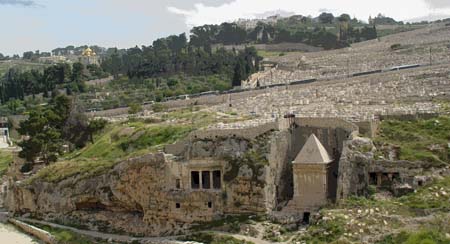
It is a beautiful day in Jerusalem, perfect for the long walk across the Kidron Valley from the old city and up to visit the Mount of Olives. (The south east corner on the map of Jerusalem.)
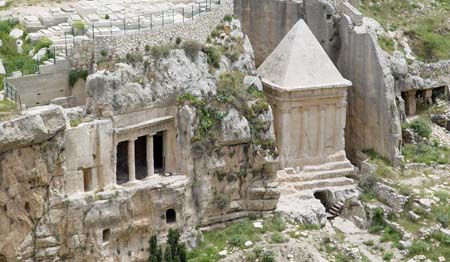
Along the way, the funeral monuments of the Kidron Valley. Pictured left, the tomb of the priestly family of Bene Hezir, left, and beside it, traditionally the tomb of the prophet Zachariah. The three ancient tombs in the Kidron Valley (cf. "Ramparts of Jerusalem" for a photo of the third.) all date back to the first and second century before Jesus. The monuments pictured here go back to the Hasmonean period famous for the Maccabean revolt commemorated each year with the celebration of Chanukah. The Hasmoneans lead the people of Jerusalem in a vigorous rejection of the influence of Greek culture, and it is interesting to note the mixture of styles, Greek colonnades and the more oriental pyramid, in the design of the Kidron Valley tombs.
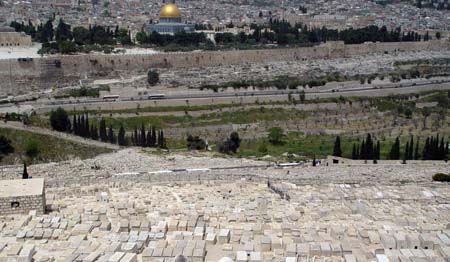
A stone stairway leads up to the steep roadway that climbs up the Mount of Olives, on my left as I climb the hill, the gardens of the Russian convent church of St. Mary Magdalene, to the right the vast fields of Jewish cemeteries, perhaps the most imposing feature of the area and in sharp contrast with the greenery to my left. Jews from around the world are buried here in thousands of stone sarcophagi.
There is a Quebec City story related to these Jerusalem burial grounds. In the late 1950s or early 1960s, the city wanted to extend St-Cyril boulevard to make a direct link between the upper city and the new campus of Laval University in Ste-Foy. In the path of the proposed straight route, the southern portion of Quebec City's Jewish Cemetery. In expropriating the land the city had to do something about the graves lying in the path of the proposed route, and the only allowable reason to disturb a Jewish grave, according to Jewish custom, would be transfer the remains for burial in Jerusalem. So the city agreed, and, possibly among the tombs pictured here, there are those belonging to a few displaced Quebeckers.
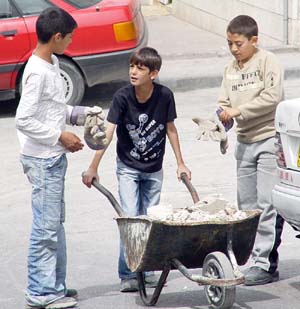
In the past, venturing anywhere near the Mount meant having to deal with swarms of very insistent Palestinian youngsters selling postcards, olive branches, and a variety of other "Holy Land memorabilia".
The increased volume of pilgrim traffic in the Holy Land has apparently eased the pressure, and these lads in a development at the top of the Mount of Olives are otherwise engaged, helping with a clean-up project in their neighbourhood. All-in-all a very good sign indeed.
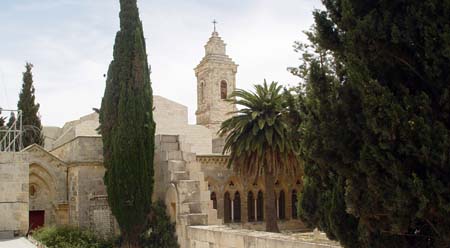
Crowning the summit of the Mount of Olives, the beautiful Carmelite Convent of the Pater Noster (Our Father.) Here, 143 translations of the Lord's Prayer are displayed in beautiful ceramics produced in the Armenian Quarter of Jerusalem. Among them the following ...
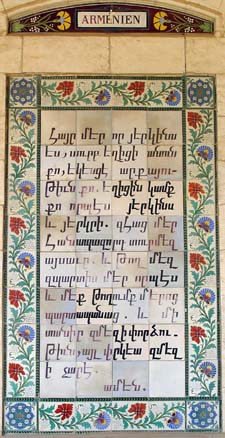 |
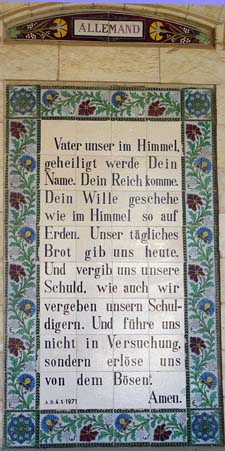 |
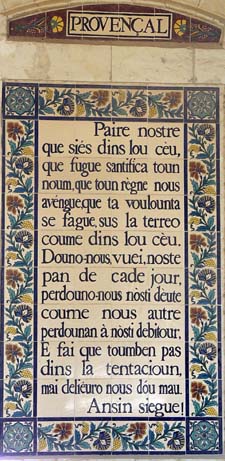 |
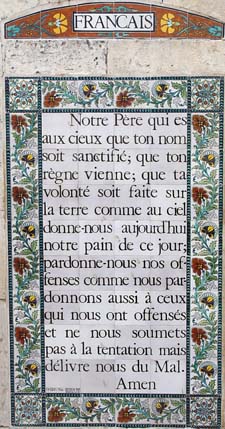 |
 |
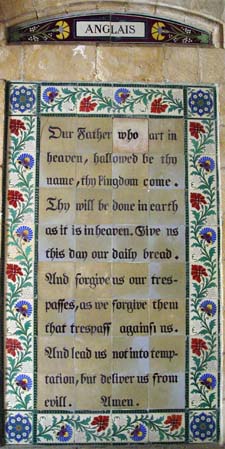 |
On entering the Pater Noster courtyard, I meet the group of pilgrims from the Malankara Syrian Orthodox Church of Kerala, India; and I take the opportunity to ask Archbishop Coorilos about the language used in their liturgy the evening before (see yesterday's post, "Malankara Visitors").
The timing for my question couldn't be better, as the Archbishop happens to be standing directly in front of the one representation of the Lord's Prayer, out of the 143 here, that is in that very language, Malayalam, just inside the gateway to the courtyard (upper right corner of the photo, below.)
It is good to see His Holiness Didymus I, Catholicos of the East, enjoying the Pater Noster courtyard with the support of one of his priests (upper right corner, as well.)
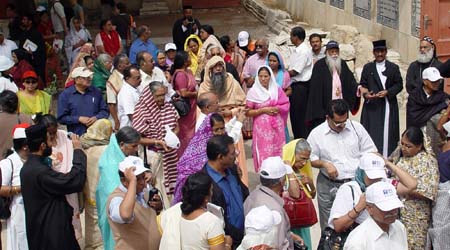
The Mount of Olives is a friendly place, no doubt thanks to enthusiasm of the many pilgrims and visitors. During the few hours I spend on the mount this morning, I have conversations with several people, both locals and pilgrims, including the French speaking staff of the Carmelite gift shop at the Convent of the Pater Noster, (two upper photos, here.)
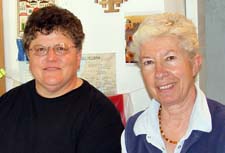 |
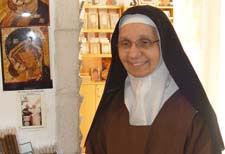 |
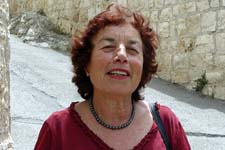 |
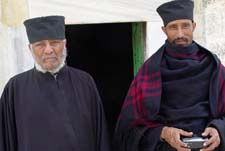 |
I also enjoy meeting a Rumanian visitor to the mount, who spots my yellow "Tour de France" cap and strikes up a conversation in French, and two Ethiopian monks, whom I meet while visiting the mosque of the Ascension of the Prophet Jesus, housing the rock from which tradition believes Jesus was lifted to the heavens, miraculously leaving a footprint behind in the stone.
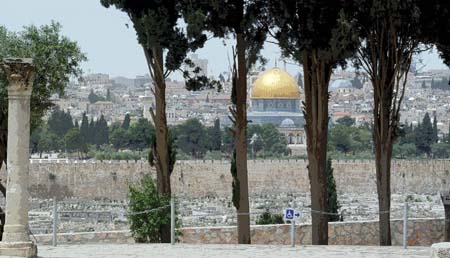
This photo (above) is taken from the grounds of a fifth century monastery, and now home to the chapel of Dominus Flevit (The Lord Wept). This is the traditional site where it is believed Jesus wept overlooking the city of Jerusalem, as reported in the Gospel of Luke (19.41). The several groups of pilgrims have gone on their way to have lunch, so this is a peaceful place at the noon hour, perfect for enjoying the picnic I have packed for the hike.
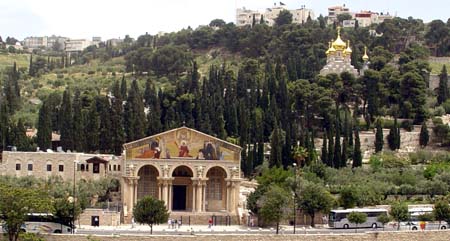
Two of the main sites on the Mount of Olives are the Russian Orthodox Convent of St. Mary Magdalene, with its distinctive bouquet of golden domes, and the basilica of All the Nations, beside the enclosed Garden of Gethsemane (lower left, above.) Both sites are closed when I reach them. The convent is only open two days a week, Tuesdays and Thursdays, and only then from 10 a.m. until noon, and the basilica closes from noon until 2 p.m. for lunch. I will need to make time, on a Tuesday or Thursday morning, for at least one more trip to the peaceful Mount of Olives, in the two weeks that remain for my pilgrimage to the Middle East.
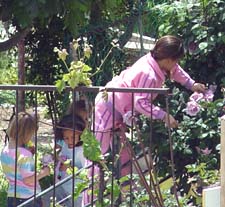 |
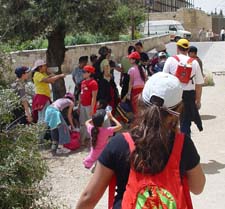 |
On my return across the Kidron Valley, I take photos of these Palestinian girls gathering roses in their backyard and of a group of the Israeli school children on a field trip to the old city. The two groups are separated only by the narrow road that runs up from the Kidron Valley along the southern wall of Old Jerusalem. South of the road, the ancient 'Ir David (City of David), predominantly Palestinian, while north of the road, the gates to the Wailing Wall and the Jewish Quarter.
Now if only we could figure out a way for the children in these photos to meet and have time to play together ... I know I'm not the first to suggest this -- there is a summer camp program in Maine, for instance, that welcomes Palestinian and Israeli teens -- but perhaps the world really could be a better place!
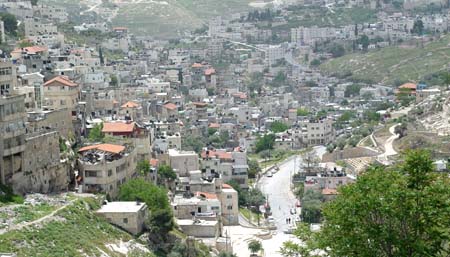
'Ir David, the City of David